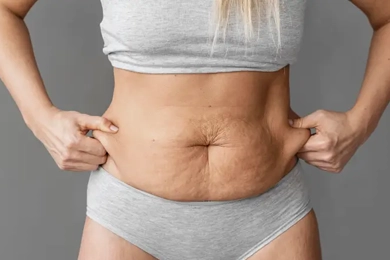
The goal of tummy tuck surgery, also referred to as abdominoplasty, is to remove extra skin and fat from the abdominal region to produce a flatter, more toned midsection. People who have undergone significant weight loss, are pregnant, or just want to make their abdomen look better frequently seek it out.
Tummy tuck surgery does have risks, just like any surgical procedure, and one that frequently comes up is whether there is a chance of death during this procedure. We will delve into the subject of tummy tuck surgery in this blog post and examine the possible risks, including the unlikely but possible risk of death.
It's critical to comprehend what a tummy tuck entails before diving into the risks. Under general anesthesia, tummy tuck surgery typically entails making an incision along the lower abdomen, followed by the removal of extra skin and fat. To produce a firmer abdominal wall, the abdominal muscles may also be tightened during the procedure. After the incisions are stitched up, the patient is typically required to wear a compression garment throughout the healing process.
Tummy tuck surgery has risks, just like any surgical procedure. These dangers can differ depending on the patient's general health, the surgeon's expertise and experience, and the kind of tummy tuck done (full tummy tuck vs. mini tummy tuck). The following are a few of the typical side effects of tummy tuck surgery:
Hematoma and Bleeding: Any surgery, including a tummy tuck, carries the risk ofbleeding. A hematoma, or collection of blood under the skin, can occasionally result from bleeding. Hematomas can cause discomfort, bruising, and swelling, and additional surgery may be needed to drain the blood and avoid complications.
Infection: Any surgical procedure carries the risk of infection. There is a chance of getting an infection at the incision site or in the surrounding tissue after a tummy tuck procedure. Infections can result in discomfort, erythema, and swelling and may be treated with antibiotics or additional surgery.
Scarring: A tummy tuck requires making incisions, which leave scars behind. Scarring is a risk of the procedure, despite the fact that surgeons work to reduce it by making incisions in hidden places, like the bikini line. Depending on the patient's unique healing process, scars may change in appearance over time but may still be visible.
Wound Healing Issues: After a tummy tuck, there is a chance of wound healing complications like delayed wound healing or wound dehiscence, which is the separation of the incision's edges. Problems with wound healing may lead to a protracted recovery, more noticeable scarring, and the need for additional treatment or revision surgery.
Seroma: Following tummy tuck surgery, a seroma is a collection of fluid. Seromas can result in swelling, discomfort, and the need for additional surgical procedures or needle drainage.
Numbness and Sensation Changes: Because the abdominal tissue is being worked on during a tummy tuck procedure, there may be numbness or other sensational changes in the affected area. Even though these modifications are typically transient, some patients may find them unsettling.
Risks associated with anesthesia: General anesthesia is frequently used during tummy tuck surgery, which has its own set of risks. These dangers could include negative effects fromallergies, respiratory problems, or negative effects on the cardiovascular system; anesthesia. Even though risks associated with anesthesia are typically uncommon, they can still pose a risk to the patient's health during the procedure.
Deep Vein Thrombosis (DVT): Deep vein thrombosis (DVT) is a condition in which blood clots form, most frequently in the legs. Patients may have a higher risk of developing DVT after tummy tuck surgery because of things like immobility during the healing process and compression of blood vessels during the procedure. A pulmonary embolism, a potentially fatal condition, can result from a blood clot that enters the lungs.
Poor Cosmetic Outcome: Although a tummy tuck is meant to improve the abdomen's aesthetic appearance, there is a chance that the procedure will have unfavorable cosmetic effects, such as asymmetry, irregularities, or unsatisfactory results. Disappointment or the need for additional revision surgery may result from this.
While the aforementioned risks are common side effects of tummy tuck surgery, the risk of death is thought to be very unlikely. The general consensus is that tummy tuck surgery is a safe procedure with a low mortality rate. However, there are inherent risks with every surgical procedure, and in rare instances, complications can occur that could be fatal.
The following are a few things that could make having a tummy tuck more dangerous:
“While the risk of death following tummy tuck surgery is regarded as rare, it is important to remember that it is not zero. Before having the procedure, it is crucial to have a thorough discussion about the potential risks with a licensed and skilled plastic surgeon.”
Despite the fact that tummy tuck surgery, like all surgeries, carries some inherent risks, there are steps that can be taken to lower the risk of complications. These consist of:
In conclusion, tummy tuck surgery is a well-liked cosmetic procedure that can significantly enhance the abdomen's aesthetic appeal. Like any surgery, it has potential risks and complications, including the risk of death, despite being generally regarded as safe. To lower the risk of complications, it is crucial to fully discuss the potential risks with a licensed and experienced plastic surgeon and to adhere to all pre- and postoperative instructions.
“If you are thinking about having a tummy tuck, you should do extensive research, select a licensed and skilled surgeon, and have reasonable expectations for the results and possible risks. You can reduce the risk of complications and have a successful tummy tuck surgery with satisfactory results by adhering to the recommended pre- and postoperative care and coordinating closely with your surgeon. When undergoing any surgical procedure, put your health and safety first.”
 10 Essential Facts About Tummy Tucks
10 Essential Facts About Tummy TucksAre you thinking of getting your tummy tucked but you have so many questions and worries? You're not by yourself. ...
 Vaser Abdominoplasty: A New Dawn in Tummy Tuck Innovation
Vaser Abdominoplasty: A New Dawn in Tummy Tuck InnovationAbdominoplasty, commonly known as a tummy tuck has long been a well-liked option for anyone hoping to get a more toned, flatter tummy. ...
 Pain After Tummy Tuck Surgery
Pain After Tummy Tuck SurgeryAbdominoplasty, also referred to as tummy tuck surgery, is a widely performed cosmetic procedure that can assist in attaining a more sculpted and flatter abdominal region. ...
 Is Tummy Tuck Surgery Painful? A Comprehensive Insight
Is Tummy Tuck Surgery Painful? A Comprehensive InsightMany people are drawn to the idea of getting a tummy tuck (abdominoplasty) in order to have a flatter, more toned abdomen. Prospective patients frequently struggle with worries about the discomfort of the su ...
 Can Diabetic Patients Have Tummy Tuck?
Can Diabetic Patients Have Tummy Tuck?Diabetes is a long-term medical illness that interferes with your body's ability to control blood sugar, or glucose. Type 1 and Type 2 diabetes result from the body's inability to use the insulin that is pro ...
 What Kind of Scar to Expect After a Tummy Tuck
What Kind of Scar to Expect After a Tummy TuckTo get a flatter, more toned abdomen, are you thinking about having a tummy tuck? It's important to realize that tummy tucks come with some degree of scarring even though they can produce noticeable aestheti ...
 What Are The Factors Affecting Tummy Tuck Prices?
What Are The Factors Affecting Tummy Tuck Prices?Abdominoplasty, sometimes referred to as a tummy tuck surgery, is a common cosmetic operation that can help people get a flatter and more toned midsection. Yet, depending on a number of variables, the price ...